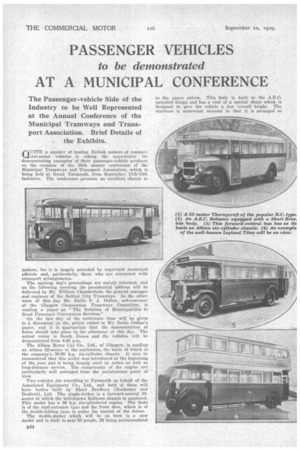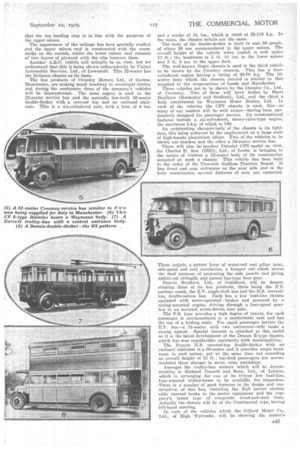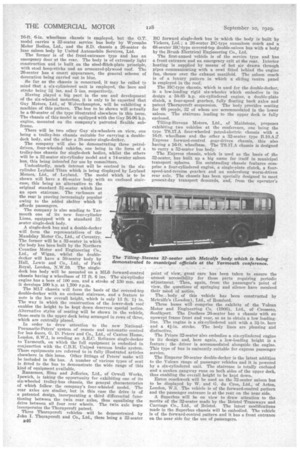PASSENGER VEHICLES
Page 70

Page 71

Page 72

If you've noticed an error in this article please click here to report it so we can fix it.
to be demonstrated
AT A MUNICIPAL CONFERENCE
The Passenger-vehicle Side of the Industry to be Well Represented at the Annual Conference of the Municipal Tramways and Transport Association. Brief Details of
the Exhibits.
• rkIJITE a numlik,T of leading British makers of commerWcial-motor vehicles is taking the opportunity for demonstrating examples of their passenger-vehicle products on the occasion of the 28th annual conference of the Municipal Tramways and Transport Association, which is being held at Great Yarmouth, from September 11th-13th inclusive. The conference presents an excellent chance to
makers, for it is largely attended by important municipal officials and, particularly, those who are concerned with transport arrangements.
The opening day's proceedings are mainly informal,and on the following morning the presidential address will he delivered by Mr. William Chamberlain, the general manager and engineer of the Belfast City Tramways. In the afternoon of this day Mr. I3ailie P. J. DoIlan, sub-convener of the Glasgow Corporation Tramways Committee, is reading a paper on 'The Relation of Municipalities to Road Passenger Conveyance Services."
Qn the last day of the conference time will he given to a discussion on the points raised in Mr. Bailie Dollan's paper, and it is appropriate that the demonstration of buses should take place in the afternoon of this day. • The actual venue is Sonth Denes and the vehicles will be demonstrated from 4.45 p.m.
The Albion Motor Car Co., Ltd., of Glasgow, is sending an Albion 32-seater to the conference, the basis of which is the company's 36-90 h.p. six-cylinder chassis. It may, be remembered that this model was introduced at the beginning of the year and is being largely used 011 urban as well as long-distance service. The components of the engine are particularly well arranged from the maintenance point of view.
Two vehicles are travelling to Yarmouth on behalf of the Associated Equipment Co., Ltd., and both of these will have bodies built by Short Brothers (Rochester and Bedford), Ltd. The single-decker is a forward-control 30seater in which the well-known Reliance chassis is employed. This model has a 95 h.p six-eylindered engine. The body is of the dual-entrance type and the front door, which is of the double-folding type, is under the control of the driver.
• The double-decker which will be on view is a new model and is built to seat 50 people, 26 being accommodated in the upper saloon. This body is hrt:lt to the A.E.C. patented desigii and has a roof of a special shape which is designed to 'give the vehicle a low overall height. The staircase is somewhat unusual in that it is arranged so that the top landing step is in line with the gangway of the upper saloon.
The -appearance of the ceilings has been specially studied and the upper saloon roof is constructed with the crosssticks on the outside, whilst the lower saloon roof consists of two layers of plywood with the ribs between them.
Another A.E.C. vehicle will actually be on view, but we understand that this is being shown independently by United Automobile Services, Ltd., of Lowestoft. This 32-seater has the Reliance.chassis as its basis.
The bus products of Crossley Motors, Ltd., of Gorton, Manchester, are making much headway in municipal circles, and during the conference three of the company's vehicles will be demonstrated. The same engine is used in the 32-seater service bus and the specially low-built 50-seater double-decker with a covered top and an enclosed staircase. This is a six-cylindered unit, with a bore of 4 ins. and a stroke of 51 ins., vl-hich is rated at 38-310 h.p. In the main, the chassis details are the same. The body of the double-decker is built to seat 50 people, of whom 26 are accommodated in the upper saloon. The overall height of the vehicle when loaded is well under 13 ft.; the headroom is 5 ft. 10 ins, in the lower saloon and 5 ft. 8 ins, in the upper deck. The well-known Eagle chassis is used in the third vehicle to be shown by the Crossley concern. This has a fourcylindered engine having a rating of 30-70 h.p. The 32seater body which the chassis carried is similar to that supplied to the corporations of Leeds and Manchester.
Three vehicles are to be shown by the Daimler Co., Ltd., of Coventry. Two of them will have bodieS by Short Brothers (Rochester and Bedford), Ltd., an the third a• body constructed by Weymann Motor Bodies, Ltd. In each of the vehicles the CF6 chassis is used, this—as many of our readers will be well aware—having been particularly designed for passenger service. Its constructional features include a six-cylinclered, sleeve-valve-type engine, the maximum b.h.p. of which is 100.
An outstanding charactevistic of the chassis is its lightness, this being achieved by the employment on a large scale of high-tensile aluminium alloys. Two of the vehicles to be shown are coaches and the other a 34-seater service bus.
There will also be another Daimler 0F6 model on view, for Charles H. Roe (1923), Ltd., of Leeds, is bringing to the notice of visitors a 32-seater body of its construction mounted on such a chassis. This vehicle has been built to the order of the Tees-side Railless Traction Board. It has front and rear entrances on the near side mid in the body construction several features of note are embodied.
These include a patent form of waist-rail and pillar joint, side-paneland roof ventilation, a bumper rail which serves the dual purpose of protecting the side panels and giving additic nal strength, and patent bar-type door gear. Dennis Brothers, Ltd., of:Guildford, will be demonstrating three of its bus products, these being the F.S. parlour coach, the EN, single-deck bus and the' HS. coveredtop, double-saloon bus. Each has a low load-line chassis equipped with servo-operated brakes and powered by a spring-mounted engine, driving through a four-speed gearbox to an inverted worm-driven rear axle:
The F.S. type provides a highdegree of luxury, for each passenger is accommodated in a' pornfortable seat and has the use of a folding table. For rapid passenger Service the E.V. bus—a 31-seater with two entrances—will make a strong appeal. Special interest is attached to this model as it is the latest development of the Dennis E-type chassis, which has won considtrable Popularity with municipalities: • The. Dennis 11.5. covered-top double-deeker with an enclosed staircase is a 50-seater and it provides ample headroom in each saloon, yet at the same time not exceeding an overall height of 13 ft. ; top-deck passengers are accommodated three abreast in seven rows amidships.
Amongst the trolley-bus makers which will be demonstrating is Richard Garrett and Sons, Ltd., of Leiston, which is arranging for one of its 0-type low load-line, four-wheeled trolley-buses to be available for inspection. There is a number of good features in the design and construction of this bus, including the Bull patent electric eddy current brake to the ynotor equipment and the company's latest type of composite wood-and-steel body. Actually the chassis will be of the Continental type, having left-hand steering, In each of the vehicles which the Gilford Motor Co., Ltd., of High -Wycombe, will be showing , the maker's 16-ft. 6-in, wheelbase chassis is employed, but the O.T. model carries a 32-seater service bus body by Wycombe Motor Bodies, Ltd., and the S.D. chassis a 26-seater de luxe saloon body by United Automobile Services, Ltd.
The former is of the front-entrance type and has an emergency door at the rear. The body is of extremely light construction and is built on the steel-flitch-plate principle, with steel hoop-sticks and an armoured-plywood roof. The 26-seater has a smart appearance, the general scheme of decoration being carried out in blue.
So far as the chassis is concerned, it may be called to mind that a six-eylindered unit is employed, the bore and stroke being 3-1 ins. and 5 ins. respectively.
Having played a big part in the use and development of the six-wheeled motorbus, it is only to be expected that Guy Motors, Ltd., of Wolverhampton, will be exhibiting a machine of this pattern. The bus to be shown will actually be a 60-seater of the type illustrated elsewhere in this issue. The chassis of this model is equipped with the Guy 56-96 h.p. engine, mounted on the company's patented flexible subframe.
There will be two other Guy six-wheelers on view, one being a trolley-bus chassis suitable for carrying a doubledeck body, and the other a 38-seater single-decker.
The company will also be demonstrating three petroldriven, four-wheeled vehicles, one being in the form of a trolley-bus chassis for single-deck bodies, whilst the others will be ft 32-seater six-cylinder model and a 14-seater saloon bus, this being intended for use by committees.
Undoubtedly, much interest will be centred in the sixcylinder Leyland Titan which is being displayed by Leyland Motors, Ltd. of Leyland. The model which is to be shown will I;ave a 48-seater body with an enclosed staircase, this being an alternative to the original standard 51-seater which has an open staircase. The enclosure at the rear is proving increasingly popular owing to the added shelter which it affords passengers.
The company is also sending to Yarmouth one of its new four-cylinder Lions, equipped with a standard 31seater single-deck body.
A single-deck bus and a double-decker will form the representatives of the Maudslay Motor Co., Ltd., of Coventry. The former will be a 32-seater in which the body has been built by the Northern Counties Motor and Engineering Co., Ltd. of Wigan, whilst the doubledecker will have a 50-seater body by Hall, Lewis and Co., Ltd. of Park Royal, London, N.W.10. The singledeck bus body will be mounted on a ML6 forward-control chassis having a wheelbase of 17 ft. 6 ins. The six-cylinder engine has a bore of 100 mm. and a stroke of 130 mm. and it develops 100 h.p. at 1,700 r.p.m.
The ML7 chassis will form the basis of tbo covered-top double-decker with an enclosed staircase, and a feature to note is the low overall height, which is only 13 ft.
The way in which the construction of the lower-deck roof enables the height to be kept down deserves special notice. Alternative styles of seating will be shown in the vehicle, those seats iTI the upper deck being arranged in rows of three, which are centrally placed.
In order to draw attention to the new NationalPneumatic-Peters' system of remote and automatic control for bus doors, G. D. Peters and Co., Ltd. of Caxton House, London, S.W.1, is sending an A.E.C. Reliance single-decker to Yarmouth, on which the full equipment is embodied in conjunction with the C.B.E. Uniped vacuum brake system. These equipments are referred to in fully illustrated articles elsewhere in this issue. Other fittings of Peters' make will be included in the bus. A number of various types of seat is fitted to the bus to demonstrate the wide range of this kind of equipment available.
Ransomes, Sims and Jefferies, Ltd., of Orwell Works, Ipswich, is taking the opportunity for exhibiting one of its six-wheeled trolley-bus chassis, the general characteristics of which follow the company's four-wheeled model. The rear axles are similar,' but in this ease the drive is of a patented design, incorporating a third differential functioning between the twin rear axles, thus equalizing the drive between all four rear wheels. The twin axle bogie incorporates the Thornycroft patent. Three Thornycroft vehicles will be demonstrated by John I. Thornyeroft and Co., Ltd., these being a 32-seater B46 The Tilling.5 demonstrated BC forward single-deck bus in which the body is built by Vickers, Ltd.; a 26-seater BC-type sunsaloon coach and a 68-seater HC-type covered-top double-saloon bus with a body by the Brush Electrical Engineering Co., Ltd.
The first-named vehicle is of the service type and has a front entrance and an emergency exit at the rear. Interior heating is supplied by means of hot air drawn through pipes communicating with a cowl fitted behind the engine fan, thence over the exhaust manifold. The saloon coach is of a luxury pattern in which a sliding centre panel is employed in the roof.
The HC-type chassis, which is used for the double-decker, is a low-loading rigid six-wheeler which embodies in its design a 58-85 h.p. six-cylindered engine, a double-plate clutch, a four-speed gearbox, fully floating hack axlce and patent Thornycroft suspension. The body provides seating for 68 people, 32 of whom are accommodated in the lower saloon. The staircase leading to the upper deck is fully enclosed.
Tilling-Stevens Motors, Ltd., of Maidstone, proposes exhibiting two vehicles at the conference, one being the type TS.17.A four-wheeled petrol-electric chassis with a 16-ft. wheelbase and the other a 32-seater type B.10.A.2` Express forward-control gear-driven chassis, this also having a 16-ft. wheelbase The TS.17.A chassis is designed to carry a 52-seater bus body.
The Express chassis, which is used as the basis of the 32-seater, has built up a big name for itself in municipal transport spheres. Its outstanding chassis features -comprise a four-cylindered engine, a single-nlate clutch, a fourspeed-and-reverse gearbox and an undershing worm-driven rear axle. The chassis has been specially designed to meet present-day transport demands, and, from the operator's point of view, great care has been taken to ensure the utmost accessibility for those parts requiring periodic adjustment. Then, again, from the passenger's point of view, the questions of springing and silence have received their meed of notice.
The . body of this vehicle has been constructed by Metealfe's (London), Ltd., of Romford.
Three buses will comprise the exhibits of the Vulcan Motor and Engineering Co. (1906), Ltd., of Crossens, Southport. The Duchess 26-seater has a chassis with an upswept frame front and rear, so as to obtain a low loadingline. The engine is a six-cylindered unit with a 3f-in, bore and a ft-in. stroke. The body lines are pleasing and distinctive.
The Prince 32-seater also embodies a six-cylindered engine in its design and, here again, a low-loading height is a feature; the driver is accommodated alongside the engine. This type of bus is eminently suitable for express passenger service.
The Emperor 50-seater double-decker is the latest addition to the Vulcan range of passenger vehicles and it is powered by a six-cylindered unit. The staircase is totally enclosed and a sunken gangway runs on both sides of the upper deck, thus enabling the overall height to be kept down.
Eaton coachwork will be used on the 32-seater saloon bus to be displayed by W. and G. du Cros, Ltd., of Acton, London, W.3. The vehicle is of the forward-control pattern and the passenger entrance is at the rear on the near side.
A Superbus will be on view to draw attention to the merits of the 32-seater made by the Bristol Tramways and Carriage Co., Ltd.. of Bristol. The latest modifications made in the Superbus chassis will be embodied. The vehicle is of the forward-control pattern and it has a front entrance on the near side for the use of passengers.




















































































































